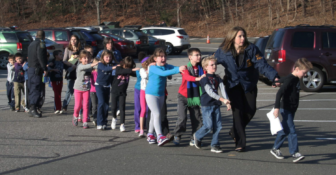After a white terrorist (can we just start calling these people what they are?) shot and killed at least 59 people and injured another 527 at an outdoor country music contest in Las Vegas this week, Nelba Márquez-Greene took to Twitter:
“Guess what folks? Gun violence and grief hurt in EVERY zip code. In every color. Grieving mothers need your help.”
Who can forget Márquez-Greene and her family? After her 6-year-old daughter Ana was shot and killed in the 2012 Newtown school massacre, Márquez-Greene and husband Jimmy Greene, the award-winning musician, have continually reminded this country that we can do more than offer thoughts-and-prayers over gun violence.
![]() We could start with devoting some research into gun violence, but with little fanfare, the federal National Institutes of Health, which touts itself as one of the leading medical research centers, has allowed to lapse a funding program that supported research into the prevention of firearm violence.
We could start with devoting some research into gun violence, but with little fanfare, the federal National Institutes of Health, which touts itself as one of the leading medical research centers, has allowed to lapse a funding program that supported research into the prevention of firearm violence.
That’s because when it comes to gun violence research, money talks. And for the past 20-some years, the money has come from the gun-rights folks, most particularly, the National Rifle Association, which has thrown its fevered support to candidates who prefer to be Know-Nothings when it comes to gun violence—to the point that they’re frightened of research that might help us figure out why we are shooting one another with such frequency. If you are against research and science, the NRA has some money for you.
This decades-long ban on funding for gun violence research has all but destroyed the field. Research for what one Stanford University researcher called the least-researched cause of death in the country mostly happens in private, if at all. This despite physicians asking that gun violence be considered a public health issue.
“My understanding from people who are doing the research is that there are such limited funds, people don’t even go into the field,” said Ron Pinciaro, executive director of Connecticut Against Gun Violence, an advocacy organization started in 1993.

Newtown Bee/Shannon Hicks Photo.
In 2012, 26 people, including 20 first-graders were shot and killed at Sandy Hook Elementary School.
In fact, the Centers for Disease Control and Prevention is left only to count the dead: 33,594 in 2014, the most recent statistics available. That’s nearly the same amount of people who die in motor vehicle accidents, and you can bet the research dollars are available to study the latter.
The NIH program has funded 22 projects for $18 million since 2014. After the Newtown shootings, President Obama signed a series of executive orders meant to add a little common sense to the way we look at guns. It didn’t work very well, particularly at the CDC, the organization most equal to the task.
This most recent defunding is not a surprise. Last April, President Donald J. Trump played to the crowd and told the NRA that “the eight-year assault on your Second Amendment freedoms has come to a crashing end.” That’s an unfortunate choice of words, but that’s come to be expected as well. Precisely what assault he was referring to is unclear. Precisely why these right-wing snowflakes don’t trust science is unclear as well.
This willful ignorance on the part of policymakers dates back to the Clinton-era Dickey Amendment, when then-U.S. Rep. Jay Dickey of Arkansas authored a bill that was inserted into an omnibus appropriations bill. His amendment didn’t explicitly ban gun violence research, but it banned funding gun control advocacy. And that’s when the NRA pounced. That industry lobbying organization began to stuff cash into the pockets of all the right (wrong) politicians. And boom! Just like that. No one was funding gun violence research.
That Dickey, a Republican, came to regret his amendment, is a nice coda, but his mea culpas matter about as much as spitting into the wind. What speaks loudest in this realm is not dead children and teachers in a Connecticut school, or countless people shot dead by loved ones, or violence in the streets, or lives cut off or altered forever by a gun. What speaks loudest is money. Pinciaro’s budget is roughly $400,000. He said the combined budget of all state and national organizations in the gun violence prevention field is roughly $80 million.
The NRA has an annual operating budget of nearly a quarter of a billion.
In 2016, the NRA pumped cash into the coffers of mostly Republican politicians. Their top recipient was the Republican National Committee. They also spent millions campaigning against Democratic candidates.
If there’s a silver lining in this cloud, it’s that Connecticut continues to set the standard for sensible gun legislation. “The good part for us is that in Connecticut, we have the second strongest gun laws in the nation,” said Pinciaro. “We feel we’ve accomplished a lot during this time.”
Susan Campbell is a distinguished lecturer at the University of New Haven. She can be reached at slcampbell417@gmail.com.